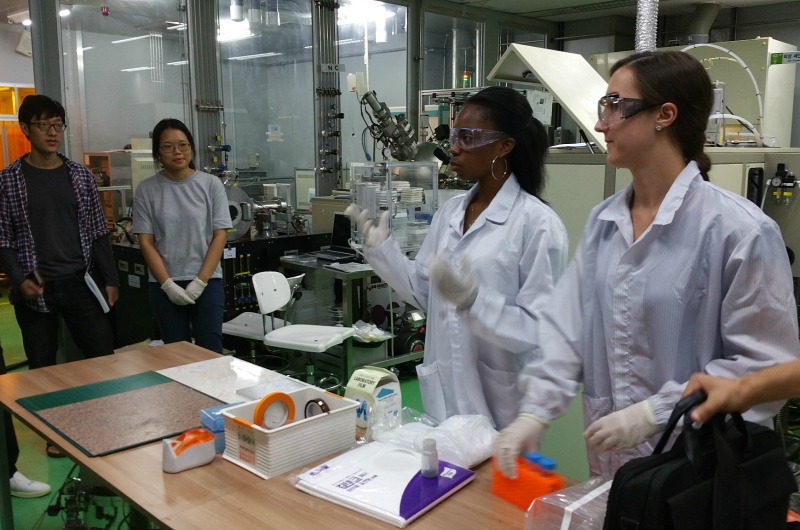
Drexel doctoral students Christine Hatter, center, and Kathleen Maleski, right, give a tutorial to South Korean students on two-dimensional material synthesis.
To bridge the gap between materials science and product fabrication, a group of Drexel Materials students and post-doctoral researchers spent the summer in South Korea as the first cohort to participate in a collaboration between Drexel University, the National Nanofabrication Center (NNFC) and the Korean Advanced Institute of Science and Technology (KAIST). Taking their knowledge of nanomaterials into a manufacturing setting, they learned that it takes big thinking to make progress on the smallest of scales.
The inaugural visit, led by Distinguished University and Trustee Chair professor Yury Gogotsi, gave the three participating students a chance to build devices using the miniscule materials they spend so much time with on campus. Through their research, the students knew what to expect when handling materials such as the MXenes discovered and developed in Drexel Materials labs. Putting them through a production line and placing them on a wafer to create a working piece of technology, though, was an eye-opening experience.
The trip gave doctoral student Christine Hatter a way to realize the end goal of her research.
“You see the potential that your material has,” she said.
Hatter spent three weeks in South Korea getting to know the scientists with whom Drexel researchers will be working in the future, and conducting short-term research. She was joined on the trip by fellow doctoral student Kathleen Maleski and postdoc Taron Makaryan, PhD, both of whom spent two to three months working on individual devices: a microsupercapacitor and a transistor, respectively.
The partnership, called the FIRST Nano2 Co-op Center and funded by a $900,000 renewable annual grant from Korea’s National Research Foundation, sent the students to the National NanoFab Center in Daejeon, South Korea, where wafers, sensors, batteries and other devices are part of the typical production research. The two groups — KAIST’s boasted roughly 20 members — worked in harmony, complementing each other’s specialty to “make two initiatives one,” Maleski said. In the process, the students saw the tangible results of their research.
“We do a lot of research that’s very fundamental, and there they do a lot of research that’s applied,” said Maleski. “I’m researching very small aspects of a really large picture. They’re combining every small aspect that we’ve been researching into this really big picture.”
Maleski said the trip helped her understand that all the studies she and her colleagues perform “actually did pay off in a real thing that came out of the line and was working.”
Hatter’s time in Korea was largely spent initiating collaborations in research areas such as electrospinning and carbon dioxide reduction. She visited collaborators at the Korean Institute of Science and Technology (KIST) and won the Best Poster award at the Nano Korea conference in Seoul.
Maleski and Makaryan, meanwhile, used an approach to their projects suggested by their Korean counterparts: building their devices halfway together before taking separate paths to the finish line. Makaryan, who was attempting to measure the electrical properties of very small particles, said he’ll need more development before proving that he has a working device, but “the first steps were made.”
The summer trip was just an introduction to a collaboration that should last six years, according to Gogotsi, who is also the director of the A.J. Drexel Nanomaterials Institute. The research will be more efficient in the second and third years, as Drexel’s students become more familiar with the tools available at the NanoFab Center. But the partnership has already been fruitful. Drexel Materials researchers are working on a paper about the electrical properties of devices tested in South Korea and their Korean counterparts have prepared a draft of a paper on the materials Drexel brought with them.
“This was just a seed,” Gogotsi said.
Gogotsi and his colleagues in the Nanomaterials Institute want to make the smallest devices possible — to improve energy storage and create a cleaner environment, among other endeavors — and programs like this one make those advances possible. The partnership will also open the door to additional collaborations with research bodies like KIST, where PhD student Amanda Pentecost is currently on a fellowship.
A group of KAIST researchers visited Drexel in early December, and the collaborators all attended the Materials Research Society’s fall meeting and exhibit in Boston. Gogotsi and his students will head back to South Korea next summer, and senior graduate students and postdoc researchers free of class responsibilities may make the trip before then.
The possibilities for progress are limited only by the ideas fueling the research and collaboration, Makaryan said. Researchers at KAIST have instruments and manufacturing lines, and Americans and others with creative vision will be the key to finding new ways to use them, he said.
The ideas brewing after the first foray in the partnership have Gogotsi energized, but it’s the prospect of discovery that makes the collaboration so significant.
“This is the most exciting thing about science,” he said. “Applications which are unimaginable now will become possible.”